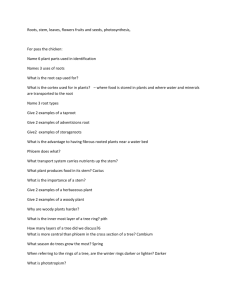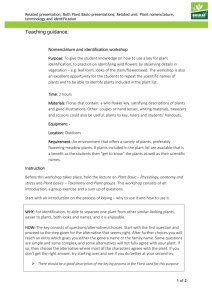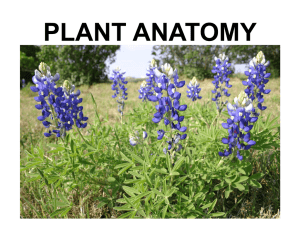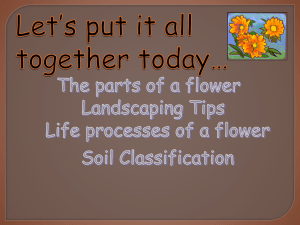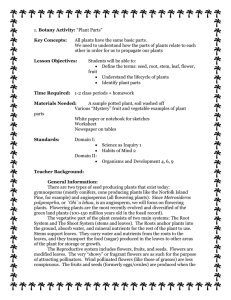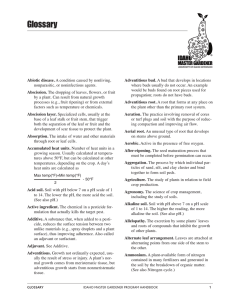Lesson Plan-Biology
advertisement
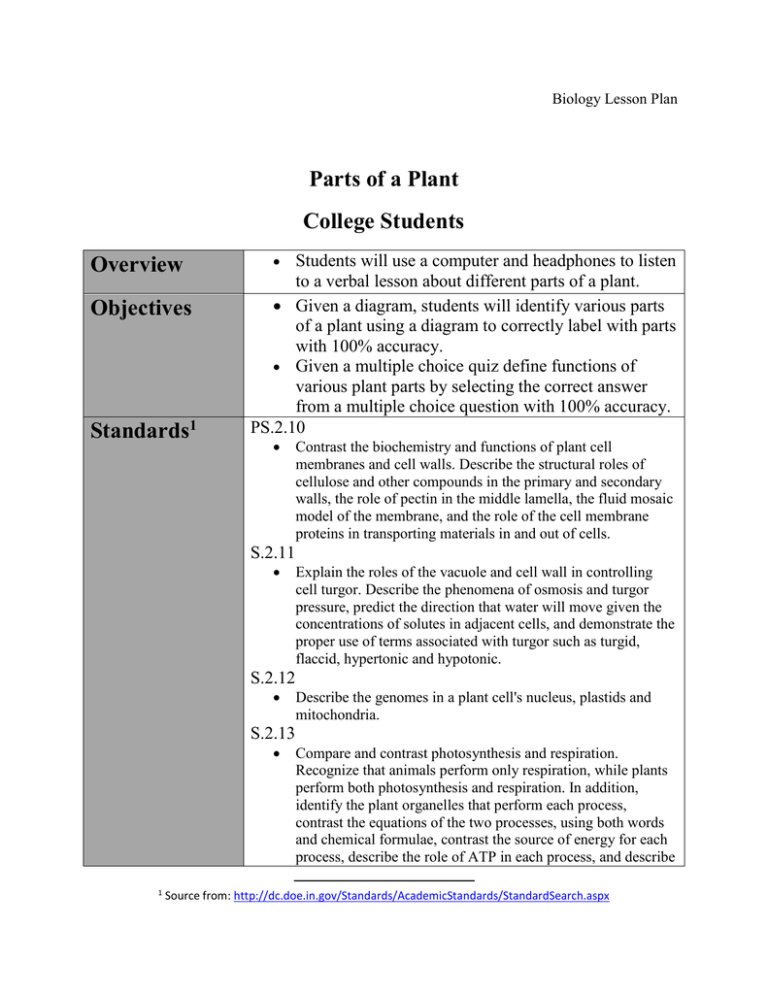
Biology Lesson Plan Parts of a Plant College Students Overview Objectives Standards1 Students will use a computer and headphones to listen to a verbal lesson about different parts of a plant. Given a diagram, students will identify various parts of a plant using a diagram to correctly label with parts with 100% accuracy. Given a multiple choice quiz define functions of various plant parts by selecting the correct answer from a multiple choice question with 100% accuracy. PS.2.10 Contrast the biochemistry and functions of plant cell membranes and cell walls. Describe the structural roles of cellulose and other compounds in the primary and secondary walls, the role of pectin in the middle lamella, the fluid mosaic model of the membrane, and the role of the cell membrane proteins in transporting materials in and out of cells. S.2.11 Explain the roles of the vacuole and cell wall in controlling cell turgor. Describe the phenomena of osmosis and turgor pressure, predict the direction that water will move given the concentrations of solutes in adjacent cells, and demonstrate the proper use of terms associated with turgor such as turgid, flaccid, hypertonic and hypotonic. S.2.12 Describe the genomes in a plant cell's nucleus, plastids and mitochondria. S.2.13 1 Compare and contrast photosynthesis and respiration. Recognize that animals perform only respiration, while plants perform both photosynthesis and respiration. In addition, identify the plant organelles that perform each process, contrast the equations of the two processes, using both words and chemical formulae, contrast the source of energy for each process, describe the role of ATP in each process, and describe Source from: http://dc.doe.in.gov/Standards/AcademicStandards/StandardSearch.aspx how hydrogen ion gradients are produced and can be used as an energy source in many cellular processes. Materials Procedures2 1. 2. 3. 4. 2 Computer Headphones Paper Pencils Diagrams Before doing this activity, students should know the following information: The basic parts of a plant The functions a plant performs Why this functions are important First have the students write down a list of functions a plant performs and fill out a diagram of the plant parts. Then, have the students listen to the verbal lesson while looking at the diagram. Next, have the students fill out another diagram and add their list of functions so they have a nice list. Sourcefrom: http://www.enchantedlearning.com/subjects/plants/label/plant/ axil - the angle between the upper side of the stem and a leaf, branch, or petiole. axillary bud - a bud that develops in the axil. flower - the reproductive unit of angiosperms. flower stalk - the structure that supports the flower. internode - the area of the stem between any two adjacent nodes. lateral shoot (branch) - an offshoot of the stem of a plant. leaf - an outgrowth of a plant that grows from a node in the stem. Most leaves are flat and contain chloroplasts; their main function is to convert energy from sunlight into chemical energy (food) through photosynthesis. node - the part of the stem of a plant from which a leaf, branch, or aerial root grows; each plant has many petiole - a leaf stalk; it attaches the leaf to the plant. root - a root is a plant structure that obtains food and water from the soil, stores energy, and provides support for the plant. Most roots grow underground. root cap - a structure at the ends (tips) of the roots. It covers and protects the apicalmeristem (the actively growing region) of the root. stem - (also called the axis) is the main support of the plant. tap root - the main root of some plants; the tap root extends straight down under the plant. terminal bud - a bud located at the apex (tip) of the stem. Terminal buds have special tissue, called apical meristem, consisting of cells that can divide nodes. Label the two lower nodes (the first and second nodes) on the plant diagram. Evaluations indefinitely. Students will hand in their first and second diagram they filled out Students will have a quiz the following week over the material



